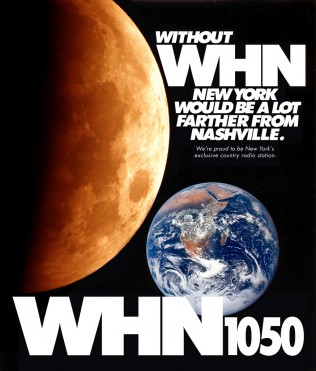On January 21, for the first time in more than 17 years, the New York radio market had a country station: Nash FM, operating at 94.7 on the FM dial. On the morning of February 26, for the first time in 25 years, it had two. While Nash broadcast from its studio above Penn Station, Farleigh Dickinson’s WFDU, broadcasting out of Teaneck, N.J., hosted the 40th-anniversary reunion of WHN, which existed in the middle of the AM dial during the ’70s and ’80s.
For nearly seven hours, the old DJs returned to the air to play some of the songs that once made WHN the most listened-to country station in the world: Earlier hits like Marty Robbins’s “A White Sport Coat (And A Pink Carnation)” and Loretta Lynn’s “Coal Miner’s Daughter” were played alongside the CB trucker songs (C.W. McCall’s “Convoy,” Red Sovine’s “Teddy Bear”) that became popular in the late ’70s; tracks like Freddy Fender’s bilingual “Before The Next Teardrop Falls” sounded as deadly as ever. There was even some overlap with the playlists of the newer station, which will occasionally acknowledge the music’s history with a throwback from George Strait or Johnny Cash.
But New York’s history with country radio stretches as far back as the era before the genre was even called country.
Barn Dancing in Manhattan
In late 1922, six months after its 100-watt transmitter sent out its first signal, Atlanta’s WSB broadcast a performance by the legendary Fiddlin’ John Carson thought to be the first country, hillbilly, or folk music ever to play over the air. Four months later, Fort Worth’s WBAP premiered the country’s first radio barn dance—an hour and a half of square dance music, directed by Captain (of the Confederate army) M.J. Bonner. Barn dance programming immediately took off, begetting programs like Chicago’s National Barn Dance and Nashville’s Grand Ole Opry, and arrived in New York via WBAP being rebroadcast off local antennas.
Born in Tennessee, Ethel Park Richardson became an accidental folklorist when musicologist Sigmund Spaeth happened to speak at the Houston school where she had become headmaster. Impressed by her knowledge of Appalachian music, Spaeth arranged a deal with his publishing company that allowed Richardson to travel the region and record—with pen and pencil—what she heard. This new career path eventually brought her to New York, where she began singing the songs over the radio, accompanying herself on zither and dulcimer.
After a successful audition at New York’s WJZ, Richardson (who was white) made her living doing the voices of black characters in handful of different programs; according to her grandson, writing in the Autumn 1977 issue of the John Edward Music Foundation Quarterly, she apparently did so with enough care and authenticity to receive gifts and letters from her substantial Harlem fanbase. Her most successful show was Hillbilly Heart-Throbs (later Heart-Throbs Of The Hills), in which she returned to the American Mountain Songs collection that had come of previous travels; each week, she dramatized a different tune.
Around the time of Heart-Throbs‘s launch, a former Broadway actor going by the name of Tex Ritter returned to New York to sing and tell stories on The Lone Star Rangers, the market’s first radio Western. [...]



